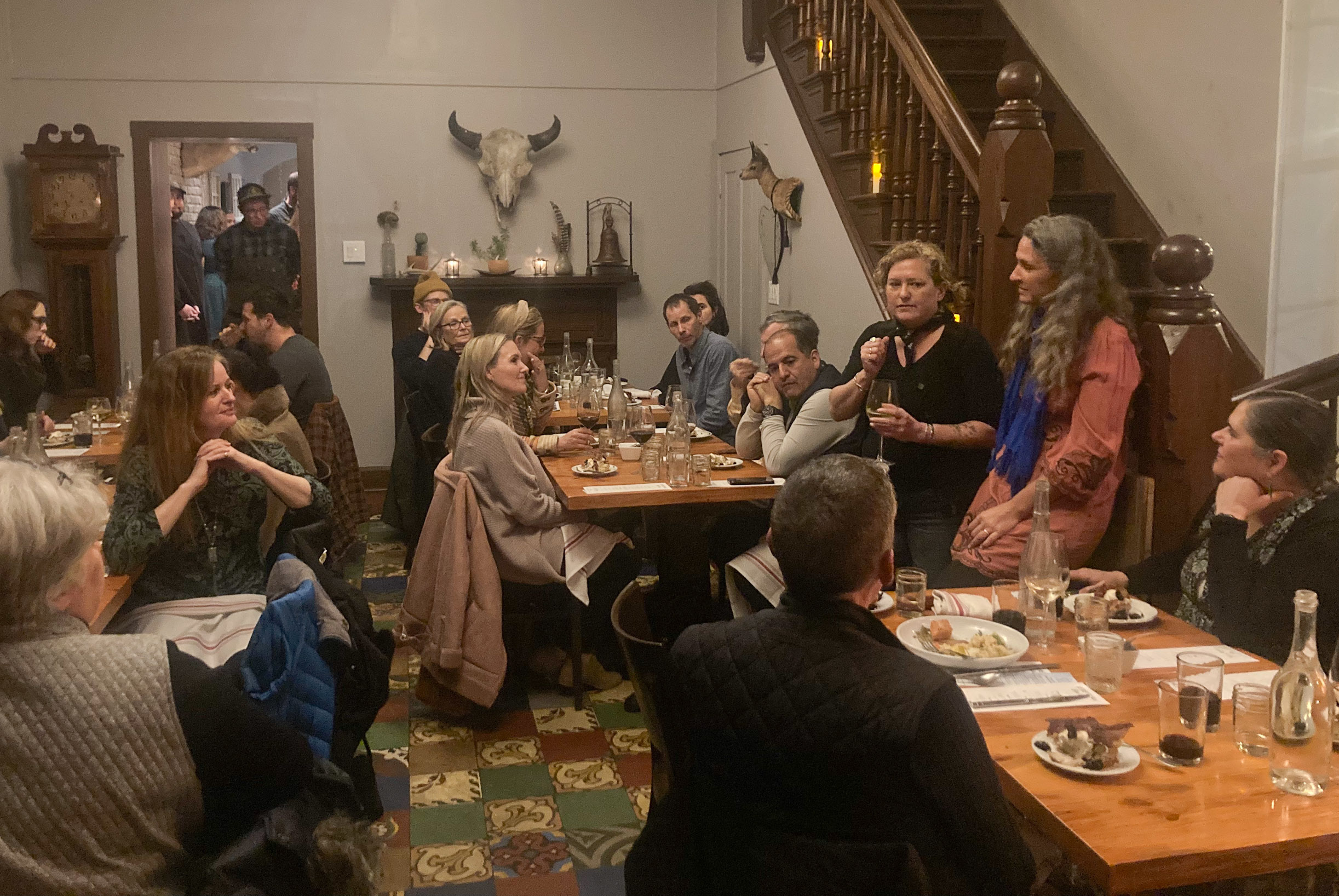Properly frozen seafood is often as good as, if not better than fresh seafood, particularly if that seafood has been out of the water for a couple of weeks. Sarah Ecolano of Copper River Fish Market in Alaska drove that point home during the KNOW FISH Dinner® at Store House Market + Eatery in Bastrop, Texas on Feb. 2.
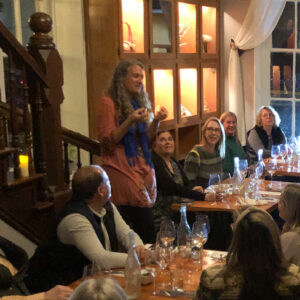
Sara Ecolano of Copper River Fish Market debunking myths about fresh vs. frozen seafood.
Sarah explained how freezing seafood locks in the flavors, nutritional profile, and cell structure as if the fish had just come out of the water. And the diners that braved the frigid, icy conditions in Texas that evening could taste what she meant in the succulent halibut chop ceviche that chefs Sonya Cote and Kate Rousset had created.
That kind of story connection, via taste, firsthand experience, and shared knowledge is what makes KNOW FISH Dinners an engaging forum for discussions about seafood with values.
This dinner was a co-production of Slow Fish North America, Slow Food USA, Store House Market + Eatery, Copper River Fish Market, Quality Seafood, and One Fish Foundation. It was the first of the Slow Fish Rising Tide events aimed at bringing seafood with values discussions to Slow Food communities across the country.
We want more people to learn the story of their seafood. We want them to seek out fish, shellfish, and seaweed that fits the Slow Fish values of good (local, seasonal, properly processed), clean (responsibly harvested in a well-managed fishery), and fair (from a fishery where the harvester and crew are paid a fair price, and where people have equitable access to good seafood).
To that extent, the evening was a huge success!
How do we know? Attendees asked great questions and engaged in thoughtful discussion about things like ecologically balanced and well-managed fisheries, climate impacts on kelp forests, transparent supply chains, and what folks can do to embrace seafood with values. They applauded after each speaker and stuck around long after dessert (a stellar bread pudding!) was served to continue the conversation.
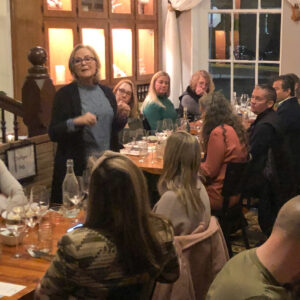
Carol Huntsberger of Quality Seafood talking about the importance of relationships.
Knowing where seafood comes from tells much about its quality and sustainability. We discussed how in general, domestically harvested seafood is better than the huge volume of imported seafood we eat in this country. Regionally sourced seafood is better, and local seafood is best. We also talked about how the definition of “local” has changed to mean as much about relationships as it is about geography. Sarah ships her salmon and halibut from the Copper River in Alaska to Sonya and Kate in Texas.
Carol Huntsberger, owner of Quality Seafood in Austin, reinforced that idea as she described the importance of fostering trust-based relationships with community-focused seafood harvesters, chefs like Sonya and Kate, and customers. She talked about the importance of transparency regarding those supply chains, and the need to educate customers about the story of the seafood she sells.
She told the story of the ginormous Texas Brown Shrimp featured in a delicious brown butter consommé for the second course. A family-run business on the Texas coast harvested the shrimp. Carol described what makes the shrimp so sweet and how it differs in appearance and taste from other types of Gulf of Mexico shrimp.
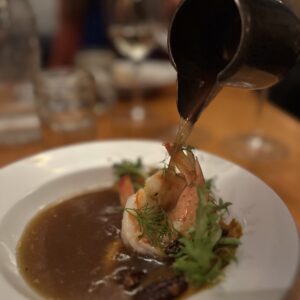
The consomme made the Texas Brown Shrimp sing.
She explained how the recent growth of small-scale mariculture oyster farms along the Texas coast is opening up new opportunities for fish harvesters and their communities.
The stories circled back to defining seafood with values within the context of being good, clean, and fair, and why we seafood eaters should take ownership of our relationship to seafood and learn more about where it comes from.
This point was especially poignant as Sarah talked about the ethos of Copper River King Salmon, widely regarded as some of the most coveted salmon in the world. Their genetics, their regionally specific diets, the pristine watershed they are born in and return to for spawning all contribute to the distinctive flavor and texture attendees experienced from the exquisitely seared fillets chefs Sonya and Kate served over a flavorful risotto.
We contrasted the sustainability of wild harvested Pacific salmon to the inherent ecological and socio-economic threats posed by industrial scale farmed Atlantic salmon. We discussed everything from widely used chemical additives (antibiotics, hormones, pesticides), to feed challenges (forage fish over-harvest, soy monocrop use with poor nutritional outcomes) and socio-economic issues (long-haul fleets from China and Spain vacuuming up the forage fish artisanal and subsistence fishermen off the West Coast of Africa depend on for their lives).
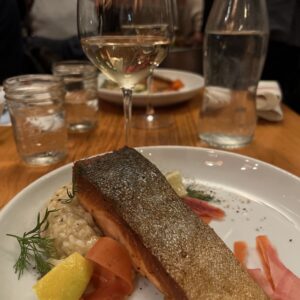
Copper River King Salmon. There is no substitute.
We ended the dinner with one question for attendees after all that we had discussed: “What’s the first question you’ll ask the next time you’re at a restaurant or seafood counter?”
Almost in unison, the group responded: “Where does the seafood come from?” Feeling newly empowered to ask fishmongers and restaurant servers questions, many folks vowed to seek out seafood that is good, clean, and fair.
This was the first Rising Tide event of several that will go down over the next few months. Huge thanks to chefs Sonya and Kate and the entire crew at Store House Market + Eatery, Sarah Ecolano of Copper River Fish Market, Carol Huntsberger of Quality Seafood, Tilia Wines for donating the wine, and Simon Solomon of Winebow Imports for providing the story of the wine! Stay tuned for more Rising Tide updates!
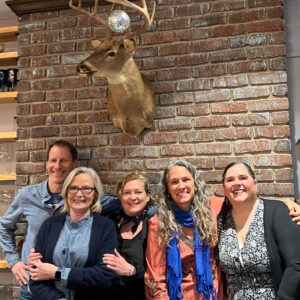
The KNOW FISH Dinner Team: Colles Stowell, One Fish Foundation and Slow Fish North America; Carol Huntsberger, Quality Seafood; Sonya Cote, Store House Market + Eatery; Sarah Ecolano, Copper River Fish Market; Mara Welton, Slow Food USA.
Top photo: Store House Market + Eatery chef/owner Sonya Cote answers questions about responsible seafood sourcing during dinner.


